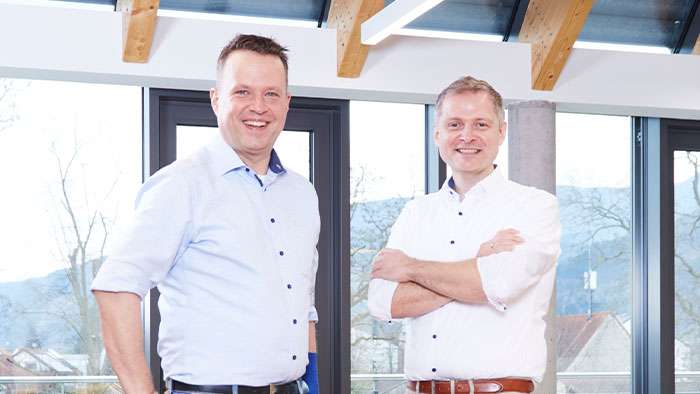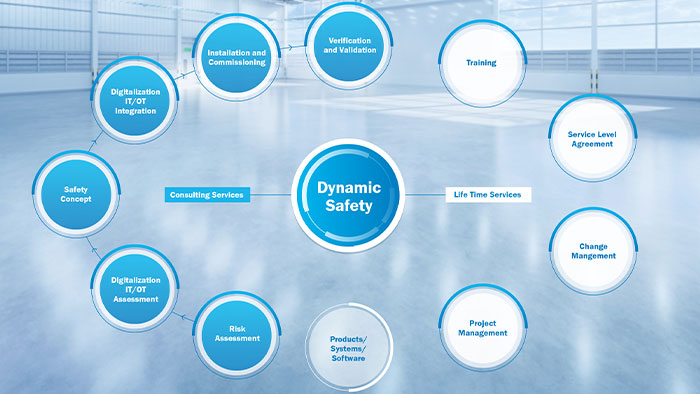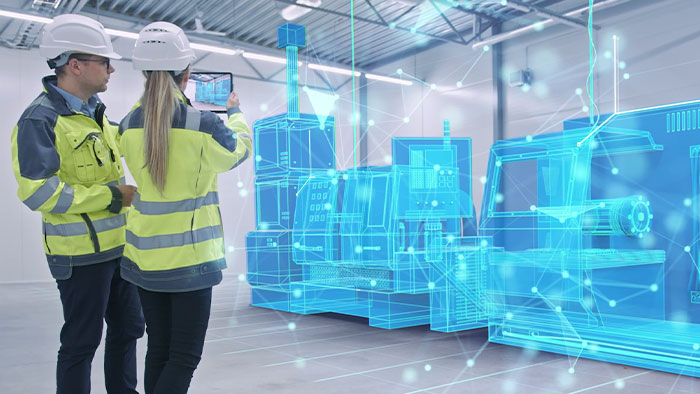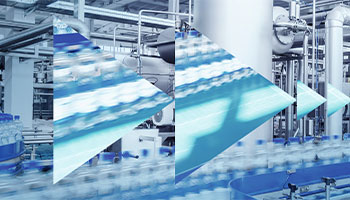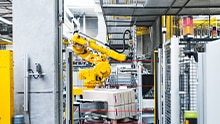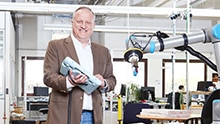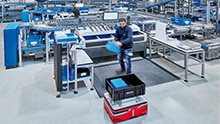The world is undergoing change. Digitalization is amplifying and accelerating this change in society and industry and having a significant impact on functional safety in the world of production. Dynamic Safety, the new holistic approach from SICK, is therefore attracting attention from the industry. Benjamin Heimpel, Head of the Business Unit Safety Systems & Services, and Patrick Vollmer, Head of the Business Unit Light Beam Systems, are convinced that Dynamic Safety will overcome previous limitations. Safety, as the safety experts explain in the interview, is thus becoming a real “game changer” for cooperation and coexistence tasks.
“Dynamic Safety overcomes the limitations of functional safety”
When you talk about dynamic safety, the term “game changer” comes up time and again. How should we classify this?
Benjamin Heimpel: Conventional security concepts can no longer keep pace with the rapid pace of development and they can limit the potential for automation. In order to overcome this, a new approach is needed. A true pioneer in safety solutions, SICK is working to make applications safe and capable of being automated, something which has not been done before.
Patrick Vollmer: However, this step is not only a game changer from SICK's perspective, but also from the customer's point of view. From conversations with our customers, we know that they recognize the immense competitive advantages they can gain with Dynamic Safety.
Why are you doing this? What is the vision behind it?

Heimpel: Because we are very close to our customers, we understand the impact that the shortage of skilled workers and ongoing global crisis scenarios are having on their productivity. There is a growing pressure on companies to automate even those areas that previously seemed impossible to automate. This is the only way to free employees from having to perform simple, repetitive tasks and allow them to focus on more interesting and challenging tasks. The major hurdle for the next step in automation is how to safeguard safety when humans and automated platforms or robots work together. And we will overcome this hurdle with Dynamic Safety.

Vollmer: Companies want to become more resilient, which means that production processes should run as smoothly as possible without disruption. To achieve this goal, resilience management, like dynamic safety, takes a holistic approach. All our measures are directed towards retaining and even improving performance despite possible crises. Intelligent solutions for areas that could cause potential disruptions in processes promote resilience. SICK can create such solutions with Dynamic Safety, drawing on our extensive expertise and knowledge of our customers' processes.
What will this look like? What is the difference between Dynamic Safety and previous solutions?
Vollmer: We no longer just look at the individual machine or danger zone for the customer, but determine in real time where people or objects are located in the entire work process. We provide data on the positions of the players, both humans and machines, and thus enable situational control of processes in a dynamic environment. This enables us to increase productivity while maintaining the quality and high throughput, and to safely automate the entire process end-to-end.
Heimpel: At SICK, as an integrated solution provider, we don't just want to sell the individual sensor, but rather take a holistic view of the applications. We support our customers in all areas, from the actual safety concept to validation, training, and project management on-site. In this business ecosystem, we operate across all levels and can thus remove limitations and create real added value for customers.
Does this mean the topic of “business ecosystems” is gaining importance at SICK?
Vollmer: Definitely! With the changes brought about by digitalization and the many challenges, such as staff shortages or the interruption of supply chains due to external events, companies must undergo organizational change. This affects in particular the logistics and production environment where, with Dynamic Safety and in cooperation with our partners, we are able to achieve not only competitive advantages for the entire network but also better, more sustainable added value.
Heimpel: We offer our customers the opportunity to work with us to systematically tackle the challenges of applications that are not yet automated. Dynamic safety in a business ecosystem brings enormous gains in resources and expertise for everyone involved. Ultimately, we can also expand the overall market of the respective sectors in a business ecosystem.
Where is SICK currently at in its development of Dynamic Safety?
Heimpel: We are currently working with pilot customers to implement our Dynamic Safety machine vision. We are testing our prototype on a 24/7 line with a global company and are actively working under real production conditions. In this way, the solution is developed in close cooperation with the customer. This is because Dynamic Safety is based on a user-centered approach, so that we can ensure the success of the developed solution with direct feedback from the application environment, from management to the employee on the production line.
Vollmer: Dynamic safety is a new approach at SICK, also internally. We want to move away from our rather rigid approach to safety, where sensors interrupt the process in the event of danger, towards a dynamic concept. One, for example, where speed reductions and routing changes no longer interrupt the production process. In future, employees will feel safe in their working environment without being consciously aware of the actual safety application. We have already received positive feedback from the pilot projects.
What is SICK's future direction in the area of safety? Could you give us a brief overview of this?
Heimpel: Dynamic Safety is one of the core topics of our “Creating Safe Productivity” strategy. We know that customers have struggled with productivity challenges in the past when it comes to safety. However, we believe that the safety of machines and systems does not have to be at odds with their productivity. On the contrary: with our new dynamic safety approach, we not only want to improve and simplify safety for the customer, but also raise productivity to a completely new, systemic and unprecedented level in the future. All in the spirit of “Creating Safe Productivity”.
What excites you personally about the new safety concept?
Heimpel: “ I find it fascinating how the dynamism that gives this concept its name also expands the boundaries of our own horizons, deepens our understanding of our customers' needs and thus accelerates the development of new solutions.”
Vollmer: We are working with Dynamic Safety to shape the future of SICK. That is very inspiring and driving for me.
Pace: Magazine for the 2023 annual report
The highly dynamic nature of markets requires solutions and technological progress is enabling these solutions to be found more quickly. We are constantly adjusting our pace so that we can both acquire and maintain a lead in the industry.
The articles in the magazine show that those who gain a head start and time through the utilization of speed can use these gains intelligently to generate new ideas and facilitate sustainable decisions.
Further articles
SICKNIFICANT
I want to stay up to date and regularly be informed about new articles!

